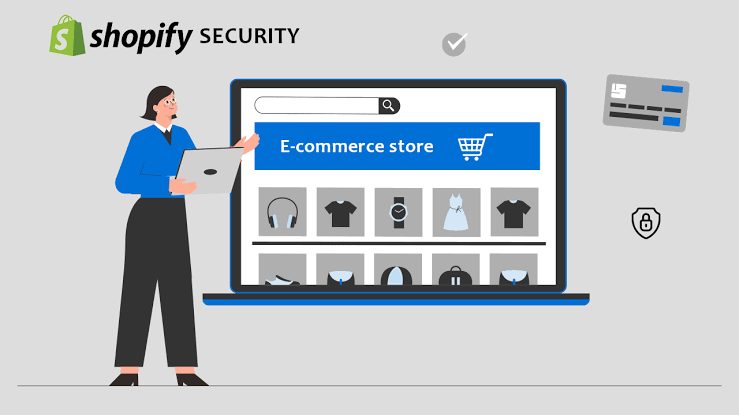Learn how to enhance the security of your Shopify store with strategies to protect customer data and prevent fraud. Discover key features like SSL encryption, PCI compliance, and two-factor authentication, along with best practices for managing and responding to security incidents.
In world of e-commerce ensuring security of online stores is crucial for protecting customer data. It also helps in maintaining trust. Shopify, leading platform for creating online stores provides various features and tools. These assist in safeguarding operations. This article explores essential aspects of Shopify store security. It focuses on methods to protect customer information. It also discusses ways to prevent fraud
Understanding Shopify's Security Features
Shopify includes several built-in security features designed to protect both store owners and customers. Knowing these features is important for maintaining robust security.
One key feature is SSL (Secure Sockets Layer) encryption which Shopify provides by default. SSL encrypts data transmitted between customer’s browser and store’s server. This ensures that sensitive information such as payment details and personal data remains secure. This encryption is indicated by padlock icon in browser’s address bar. It reassures customers that their information is protected.
Shopify also adheres to PCI (Payment Card Industry) compliance standards. This means Shopify follows strict guidelines for handling credit card information securely. These include secure storage and transmission practices. PCI compliance is essential for preventing unauthorized access to payment details.
Two-factor authentication (2FA) is another security measure offered by Shopify. 2FA adds an extra layer of protection. It requires users to provide a second form of verification, such as code sent to their mobile device in addition to their password. This helps protect store access from unauthorized users.
Fraud analysis tools provided by Shopify help identify and manage potentially fraudulent transactions. These tools assess various risk factors. They generate alerts for suspicious activities. This allows store owners to take proactive measures to prevent fraud.
Best Practices for Protecting Customer Data
In addition to Shopify’s built-in features there are several best practices store owners should follow to further enhance security
Keeping software up to date is crucial for maintaining security Regularly updating Shopify and any third-party apps ensures you benefit from latest security patches and improvements These updates often address known vulnerabilities and enhance overall security
Using strong, unique passwords for Shopify admin panel and related accounts is vital Implementing access controls by restricting user permissions based on roles further protects sensitive areas of store from potential breaches
When integrating third-party apps or plugins it is important to choose reputable sources and ensure these apps follow security best practices Researching app security features and reading user reviews helps identify and avoid apps that may pose security risks
Regularly backing up store data is essential for recovery in case of data loss or security incidents. Shopify provides backup options. However maintaining your own backups of critical data offers an additional layer of protection. This includes customer information and transaction records.
Preventing and Managing Fraud
Fraud prevention is critical aspect of securing Shopify store. Implementing strategies to detect and manage fraud can help protect both business and its customers. Regularly monitor transaction activity. This can help identify unusual patterns or suspicious behavior. Look for signs such as multiple failed payment attempts or high-value transactions from new accounts. Inconsistent shipping addresses may also be a red flag. Early detection of these activities can help prevent fraud.
Address verification systems (AVS) can reduce fraud by checking billing address provided by customer against address on file with credit card issuer. Enabling AVS for transactions adds extra layer of verification. For higher-risk transactions consider setting up manual review processes where staff examine orders before processing. This additional scrutiny helps catch fraudulent transactions that automated systems might overlook.
Educating and training staff on security best practices and potential fraud schemes is essential. Regular updates and training sessions help staff recognize and respond to suspicious activities effectively
Responding to Security Incidents
Despite best security measures incidents may still occur. Having response plan in place is crucial for minimizing damage and recovering effectively.
Develop comprehensive incident response plan outlining procedures for addressing security breaches or fraud incidents. This plan should include steps for identifying and containing the incident. Communicating with affected parties is essential. Implement corrective actions to prevent future occurrences.
If security breach affects customer data, promptly notify affected individuals. Provide guidance on protecting their information. Transparency and timely communication help maintain customer trust. They also mitigate potential reputational damage.
After addressing security incident review and improve security measures. Address any vulnerabilities or weaknesses exploited during incident. Use these insights to enhance overall store protection.
Conclusion
Securing Shopify store is essential for protecting customer data and preventing fraud. By leveraging Shopify’s built-in security features following best practices and implementing effective fraud prevention strategies, store owners can create secure online shopping environment. Regular updates are important. Strong password practices play a significant role. Secure app integrations and vigilant monitoring are key to maintaining store security. Additionally having robust response plan ensures effective management of any security incidents. This minimizes damage and protects both business and its customers. Staying proactive in security efforts is crucial for maintaining trust. It ensures success of Shopify store.
